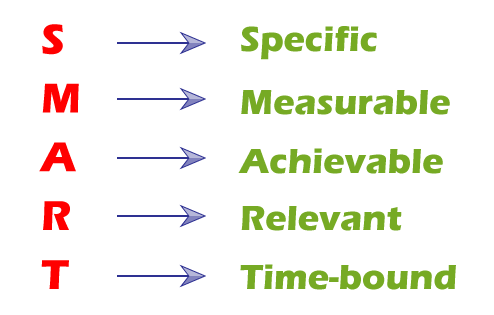What is the Full Form of SMART?SMART is a management term used to set goals. SMART is a mnemonic acronym, giving criteria to guide setting objectives, such as project management, employee performance management, and personal development. The letters S and M generally mean specific and measurable. Possibly the most common version has the remaining letters referring to achievable, realistic, and timely. However, the term's inventor had a slightly different version, and the letters have meant different things to different authors. Therefore, additional letters have been added by some authors. Although the acronym SMART generally stays the same, objectives and goals can differ. Goals are the distinct purpose that is to be anticipated from the assignment or project. On the other hand, objectives are the determining steps to complete the project goals. The November 1981 issue of Management Review contained a paper by George T. Doran called an S.M.A.R.T. way to write management's goals and objectives. It discussed the importance of objectives and the difficulty of setting them. Elements of a SMART Business GoalEvery successful business has set and articulated goals to attain specific objectives. It is a simple tool used by businesses to go beyond the kingdom of unclear goal-setting into an actionable plan for results. 
SMART is an acronym for the five elements of specific, measurable, achievable, relevant, and time-based goals. 1. S - Specific Specific goals have a significantly greater chance of being accomplished. It stresses specifying a specific goal rather than a general one. A specific goal will usually answer the "Why", "What", "Who", "Which", and "Where" questions. You must consider these five questions to make a specific goal:
For example, a general goal would be "I want to get in shape." A more specific goal would be "I want to obtain a gym membership at my local community center and work out four days a week to be healthier." 2. M - Measurable A SMART goal must-have criteria for measuring progress. If there are no criteria, you will not determine your progress and if you are on track to reach your goal. To make a goal measurable, ask yourself these questions:
For example, I want to obtain a gym membership at my local community center and work out four days a week to be healthier. Every week, I will aim to lose one pound of body fat. 3. A - Achievable A SMART goal must be achievable and attainable to be successful. It will help you figure out ways you can realize that goal and work towards it. The achievability of the goal should be stretched to make you feel challenged but defined well enough that you can achieve it. When you set an achievable goal, you may identify previously overlooked opportunities or resources to bring you closer to it. Ask yourself these questions:
For example, you might need to ask yourself whether developing the skills required to become head of marketing is realistic, based on your existing experience and qualifications. And do you have the time to complete the required training effectively? Are the necessary resources available to you? Can you afford to do it? 4. R - Realistic A SMART goal must be realistic in that the goal can be realistically achieved given the available resources and time. This step is about ensuring that your goal matters to you and aligns with other relevant goals. A SMART goal is likely realistic if you believe that it can be accomplished. Ask yourself these questions:
For example, you might want to gain the skills to become head of marketing within your organization, but is it the right time to undertake the required training or work toward additional qualifications? Are you sure that you're the right person for the head of the marketing role? Have you considered your spouse's goals? 5. T - Time-bound A SMART goal must be time-bound in that it has a start and finish date. If the goal is not time-constrained, there will be no sense of urgency and less motivation to achieve the goal. Ask yourself these questions:
To make your business goals are SMART, break down each goal into a specific set of tasks and activities to accomplish the goals. It's important to review your goals and make adjustments, if necessary, periodically. Goal setting for your small business is an essential tool for success. Remember in the end to be SMART. For example, on 1 June, I will obtain a gym membership at my local community center. I will work out 4 days a week. Every week, I will aim to lose one pound of body fat. By the end of June, I will have realized my goal to lose 4 pounds of fat within a month. Benefits of using SMARTHere are the following advantages of using SMART to set your goals and in your business:
Drawbacks of Using SMARTThe SMART term also has some drawbacks, such as:
SMART in Terms of TechnologySMART or Self-Monitoring, Analysis, and Reporting Technology is a system to watch computer hard disks to help stop the risk of failures. Its primary function is to detect and report various indicators of drive reliability with the intent of anticipating imminent hardware failures. When SMART data indicates a possible imminent drive failure, software running on the host system may notify the user so preventive action can be taken to prevent data loss. The failing drive can be replaced and data integrity maintained. Hard disk and other storage drives are subject to failures which can be classified within two basic classes:
Next TopicFull Forms List
|
 For Videos Join Our Youtube Channel: Join Now
For Videos Join Our Youtube Channel: Join Now
Feedback
- Send your Feedback to [email protected]
Help Others, Please Share










